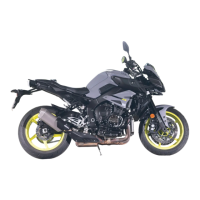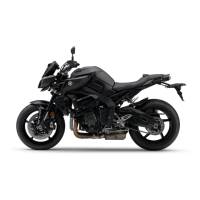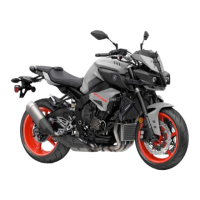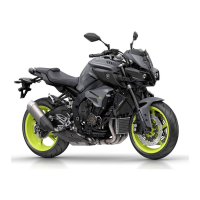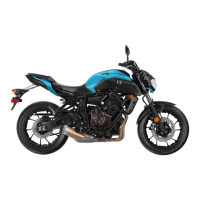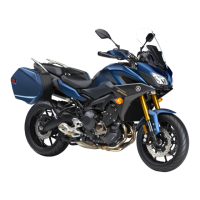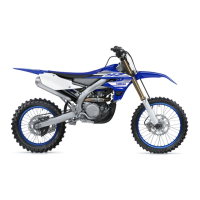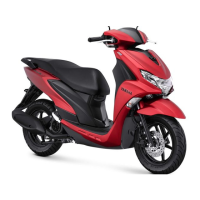Do you have a question about the Yamaha MT-10 2019 and is the answer not in the manual?
Owner's responsibility for safe and proper motorcycle operation, including obtaining instructions and training.
Guidelines for safe motorcycle operation, emphasizing pre-operation checks and rider awareness.
Importance of wearing helmets, face shields, jackets, boots, gloves for injury prevention.
Precautions against deadly carbon monoxide gas from engine exhaust in enclosed areas.
Advice on adding cargo, weight limits, and securing items to maintain stability.
Hazards of installing aftermarket parts or modifications that can affect vehicle safety.
How to activate, set, adjust, and deactivate the cruise control system.
Explanation of the electronically controlled engine performance system and its modes.
How the TCS works to maintain traction and its available settings.
Description of the system allowing clutchless upshifts and its operating conditions.
Details on the anti-theft immobilizer system, keys, and indicator light.
Explanation of the Anti-lock Brake System and its operation.
Verifying front and rear brake operation, pads, and fluid levels.
Conditions required for starting the engine and initial warning light checks.
Recommended guidelines for breaking in the new engine to ensure longevity.
Instructions for checking engine oil level, changing oil, and replacing the filter.
Checking brake pads, fluid level, and changing brake fluid.
Charts and procedures for diagnosing and resolving starting or performance problems.
Steps to diagnose and address engine overheating issues.
Owner's responsibility for safe and proper motorcycle operation, including obtaining instructions and training.
Guidelines for safe motorcycle operation, emphasizing pre-operation checks and rider awareness.
Importance of wearing helmets, face shields, jackets, boots, gloves for injury prevention.
Precautions against deadly carbon monoxide gas from engine exhaust in enclosed areas.
Advice on adding cargo, weight limits, and securing items to maintain stability.
Hazards of installing aftermarket parts or modifications that can affect vehicle safety.
How to activate, set, adjust, and deactivate the cruise control system.
Explanation of the electronically controlled engine performance system and its modes.
How the TCS works to maintain traction and its available settings.
Description of the system allowing clutchless upshifts and its operating conditions.
Details on the anti-theft immobilizer system, keys, and indicator light.
Explanation of the Anti-lock Brake System and its operation.
Verifying front and rear brake operation, pads, and fluid levels.
Conditions required for starting the engine and initial warning light checks.
Recommended guidelines for breaking in the new engine to ensure longevity.
Instructions for checking engine oil level, changing oil, and replacing the filter.
Checking brake pads, fluid level, and changing brake fluid.
Charts and procedures for diagnosing and resolving starting or performance problems.
Steps to diagnose and address engine overheating issues.
| Displacement | 998 cc |
|---|---|
| Bore x Stroke | 79.0 mm x 50.9 mm |
| Compression Ratio | 12.0:1 |
| Maximum Power | 118.0 kW (160.4PS) @ 11, 500 rpm |
| Maximum Torque | 111.0 Nm (11.3 kg-m) @ 9, 000 rpm |
| Fuel System | Fuel Injection |
| Ignition System | TCI |
| Transmission | 6-speed |
| Final Drive | Chain |
| Front Suspension | Telescopic forks, Ø 43 mm |
| Rear Suspension | Swingarm, (link suspension) |
| Rear Brakes | Hydraulic single disc, Ø 220 mm |
| Front Tyre | 120/70 ZR17 M/C (58W) |
| Rear Tyre | 190/55 ZR17 M/C (75W) |
| Dimensions (L x W x H) | 2, 095 mm x 800 mm x 1, 110 mm |
| Seat Height | 825 mm |
| Wheelbase | 1, 400 mm |
| Minimum Ground Clearance | 130 mm |
| Wet Weight | 210 kg |
| Fuel Tank Capacity | 17 liters |
| Starter System | Electric |
| Engine Type | Liquid-cooled, 4-stroke, DOHC, 4-valve |
| Frame | Deltabox |
| Front Brakes | Dual 320mm hydraulic disc |

